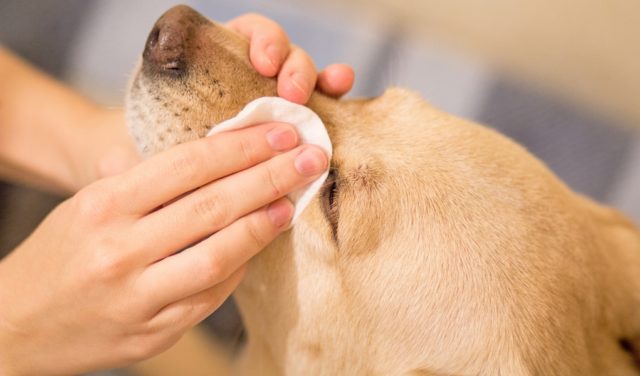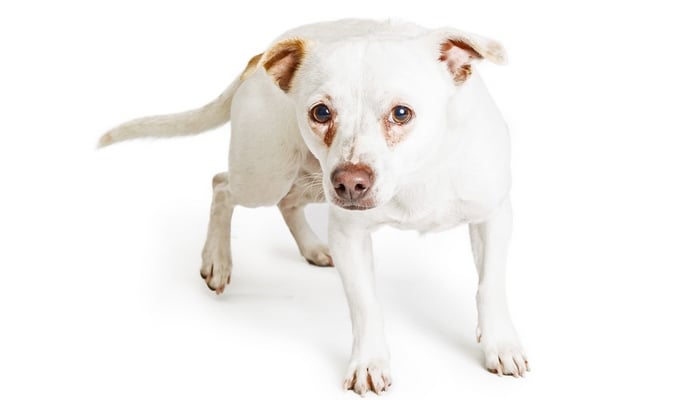
Table of Contents
Your beautiful white dog has gotten rusty-looking stains all around its big, beautiful eyes.
You give your dog a bath and try your best to clean it off, but it still comes out looking like raccoon eyes.
The local groomer mentioned a product called Angel Eyes that you can get from your veterinarian, and it got you looking online to find Angel Eyes for Dogs reviews.
Angel Eyes is a product that is made for removing stains from around a dog’s eyes.
If you read Angel Eyes for Dogs reviews, you'll learn that it works to abolish the muddled tear stains around the eyes but also rids beard stains and paw stains on dogs.
Tear staining shows a reddish-brown rust discoloration on the fur that can be found around the dog’s eyes, mouth, paws, and genital areas.
Groomers love Angel Eyes because it works great for cosmetic purposes. It is a well-known product for eliminating tear stains.
It works to kill off the yeast that causes the pigment change that leads to the reddish-rusty look on the fur.
The problem (which most Angel Eyes for Dogs reviews don't tell you) is that it contains an antibiotic, and it has to be used on a daily basis in order for it to be effective.
So, now that you know what the product is let's find out if it's safe.
THIS PRODUCT IS NO LONGER AVAILABLE
Angel Eyes for Dogs Reviews
Is it safe for pets, and what are the side effects?
Is Angel Eyes Safe for Dogs?
Angel Eyes has been used effectively on pets for stain removal for many years and claims to be safe and “paraben-free.”
It proudly shows off its seal of approval from the NASC (National Animal Supplement Council).
However, the problem is the active ingredient – tylosin tartrate – an antibiotic.
Because it is given in the food as a powder daily for life, it is not recommended nor considered wise by veterinarians.
If you feed your pet antibiotics every day, you are courting bacterial resistance and antibiotic-resistant superbugs.
The U.S. Food and Drug Administration issued warning letters that companies were manufacturing unapproved animal drugs in products to remove tear stains.
The FDA warned that Angel Eyes and other similar products were not approved for use in dogs or cats.
They also warned that these products have been associated with side effects and conditions such as epiphora.
If you read some Angel Eyes for Dogs reviews, you'll see that some pet owners have noticed these side effects after just a few months of use.
Possible Side Effects of Angel Eyes for Dogs
Angel Eyes is used as a food supplement, and it contains tylosin, which is an antibiotic.
It is generally considered safe, but considering that it is used daily for life, it can come with a number of side effects.
Common side effects that you should watch for include the following:
- diarrhea
- swallowing problems
- dizziness
- hives
- inflamed tongue
- light Sensitivity
- loss of appetite
- nausea
- vomiting
- swelling
- problems with vision
Less common and rare side effects include serious conditions such as anemia, blood disorders, muscle weakness, and inflammation of the throat.
Consider all of these side effects for the cost of cosmetic purposes to make the owner feel better.
Many veterinarians disagree with the use of products like Angel Eyes because antibiotics like tylosin are contained in the medication.
Using low-dose antibiotics daily for life sets your dog up for antibiotic-resistant superbugs.
You would also be setting your dog up for bacterial resistance to any illnesses that your dog may come across.
RELATED: 25 Most Serious Dog Health Symptoms That Cannot Be Ignored
Eye Conditions in Dogs
The first thing you should do when you have a staining problem is go see your vet.
Tear staining is most commonly caused by excess tear production or tear ducts that are not properly draining.
Common conditions called entropion and ectropion, which block tear ducts due to the eyelids turning in or out, also cause tear staining.
Many dogs are predisposed genetically to having eye problems, and there’s not much you can do for your dog but learn to groom around it.
Your vet may offer some type of surgical correction, but in many cases, the tear staining will recur.
Talk to Your Vet
Talking to your veterinarian can help alleviate a lot of worry about your dog.
Your vet can check for any eye conditions that can be causing the discoloration. If there is an underlying eye condition, your vet can recommend treatment or surgery.
Veterinarians may help you find out more about your particular breed of dog and how to best treat your dog’s rusty eye problem.
Going to your vet helps to develop your relationship and alleviates the fear that something could be wrong with your dog.
Your vet may also know a good groomer in the area who can work with your dog and help with tear stains.
Talking to your vet can be a great source of information.
RECOMMENDED VIDEO GUIDE: How To Clean Dog Tear Stains
Getting Rid of Tear Stains on Dogs
It can take a lot of grooming and regular cleaning to rid your dog of raccoon eyes.
Bad tear staining can be contagious, and having constant wetness under the eyes can lead to a secondary bacterial eye infection.
Your dog can develop secondary staph or yeast infections in areas that are constantly wet.
If you have more than one dog, they can pass it back and forth.
Taking extra time to disinfect the dog’s environment with regular cleaning and anti-bacterial dish soap, bleach, or Lysol will help kill off any extra bacteria.
Once you’ve cleaned the environment, you can start with a good grooming process for your dog.
Even though Angel Eyes for Dogs reviews report that the product works to remove stains, there is a safer way to get rid of this unsightly issue.
Follow this step-by-step approach to get your dog’s eyes pearly white:
- Clean – Twice a day, take cotton balls soaked in warm water and clean your dog’s eyes. Use one cotton ball per eye. Try to keep the tears from staining, to begin with.
- Clip – Clip the fur that is just under the eye clipped very short. There are clippers designed for this purpose: train your dog to allow you to clip close and keep the fur trimmed neatly. If you have trouble with this, get to a professional groomer or your vet for help.
- Dab – After drying the area, use a dab of Vaseline on the wettest areas of the fur. This would be the area that accumulates the most tears and has the most chance of staining.
- Diet – Your current diet may not be working. You may try a different diet that could help alleviate some of the tear staining. Ask your vet for recommendations, or try a more natural diet source.
- Wipes – There are many commercially available wipes that are good for cleaning tear stains around dog’s eyes. They are designed to keep the area clean and stain-free throughout the day and have milder ingredients than those that would be ingested. Ask your groomer what brand they recommend. These wipes will keep your dog’s eyes clean throughout the day.
- Probiotics – Probiotics have been shown to help not only your dog’s intestinal health but also to reduce problems like tear staining. The natural bacterial additives found in foods, such as IAMS Prostora MAX, have been found to work very well.
Making the Choice to Use Angel Eyes
While some Angel Eyes for Dogs reviews state how well the product works, it may not be the best choice for your pup.
As a dog owner, you want the best for your dog.
Your dog is like family, and it can be hard to see him have a problem as obvious as tear stains. We all want our dog to look his best, but we also need to realize that this is but a cosmetic problem.
Once you have taken your dog to the vet and eliminated any medical issues, the problem with the tear staining is simply cosmetic.
Groomers have stated that Angel Eyes works great, and that may be so for the short term.
Any antibiotic that your dog takes should be just that, short-term.
Taking antibiotics for a lifetime for a cosmetic issue with many side effects, including serious ones, doesn’t sound like a choice that most dog owners would make.
Even though the Angel Eyes for Dogs reviews clearly show that the product works, it's not a good long-term solution.
The best choice, in the end, is to go to your vet and start a conversation.
Learn the best way to groom your dog to eliminate the problem without using products such as Angel Eyes.














